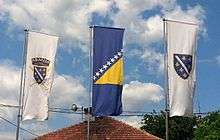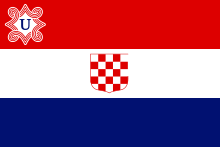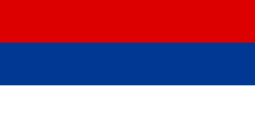Flag of Bosnia and Herzegovina
 | |
| Use | National flag |
|---|---|
| Proportion | 1:2 |
| Adopted |
4 February 1998 (Updated: 10 August 2001)[1] |
| Design | A wide medium blue vertical band on the fly side with a yellow right triangle abutting the band and the top of the flag; the remainder of the flag is medium blue with seven full five-pointed white stars and two half stars top and bottom along the hypotenuse of the triangle. |
| Designed by | Carlos Westendorp |

The national flag of Bosnia and Herzegovina contains a wide medium blue vertical band on the fly side with a yellow right triangle abutting the band and the top of the flag. The remainder of the flag is medium blue with seven full five-pointed white stars and two half stars top and bottom along the hypotenuse of the triangle.
The three points of the triangle stand for the three constituent peoples of Bosnia and Herzegovina: Bosniaks, Croats, and Serbs.[2] The triangle represents the approximate shape of the territory of Bosnia and Herzegovina.[3] The stars, representing Europe, are meant to be infinite in number and thus they continue from top to bottom. The flag features colours often associated with neutrality and peace – white, blue, and yellow. They are also colours traditionally associated with Bosnia.[3] The blue background is suggestive of the flag of Europe.[4]
History
Western Herzegovina 1760 flag
The green flag with the white crescent and star pointing to the left was used by Bosniak landlords in border parts in southern and western Herzegovina. The flag was most commonly used in wars. It also accompanied the troops of the Eyalet of Bosnia during the second siege of Khotyn in Bukowina. It differs from Ottoman flag by size and direction of crescent, but also it is swallow-shaped, like some West-European jacks and ensigns.
 Western Herzegovina flag, 1760
Western Herzegovina flag, 1760
Bosnian Revolt of 1830s flag
In the 1830s revolt by Husein Gradaščević the green flag with a yellow crescent and star was used. The revolt's aim was for Bosnia to gain autonomy from the Ottoman Empire.
.svg.png) Bosnian Revolt Flag, 1831
Bosnian Revolt Flag, 1831
Bosnian Vilayet 1867–1908 and brief independence 1878
In 1878 Bosnia existed briefly as an independent nation. Its flag was very similar to the flag used by Husein Gradaščević's revolt of 1830. It was green with a yellow crescent and star, but had more curvature to a typical Islamic crescent moon symbol. Bosnia was independent in 1878 for a few months, after the Ottoman troops left, but shortly afterward the Austro-Hungarians occupied Bosnia after an agreement reached in Berlin among major European powers. The green/golden flag was in use for about only two months.
.svg.png) Independent Bosnia, 1878
Independent Bosnia, 1878
Austro-Hungarian rule
When the Austro-Hungarian Empire annexed Bosnia and Herzegovina the flag was changed. The province of Bosnia used the flag that was red and yellow horizontally, but the province of Herzegovina used the same flag but with reversed colors. (yellow and red).
The coat of arms is one of Stjepan Vukčić Kosača, Bosnian noble and duke from 14th century. The original medieval coat of arms had a white background and two red stripes in the top of the shield.
.svg.png) Flag of Bosnia during Austro-Hungarian administration (the country was formally under the sovereignty of the Ottoman Empire) (1878–1908)
Flag of Bosnia during Austro-Hungarian administration (the country was formally under the sovereignty of the Ottoman Empire) (1878–1908).svg.png) Flag of Herzegovina after Austro-Hungarian annexation (1908)
Flag of Herzegovina after Austro-Hungarian annexation (1908).svg.png) Flag of Bosnia after Austro-Hungarian annexation (1908)
Flag of Bosnia after Austro-Hungarian annexation (1908)
Independent State of Croatia (1941–1945)
As the entire territory of modern Bosnia and Herzegovina was part of the Independent State of Croatia, a puppet state of Nazi Germany during World War II, the flag is similar to the flag of Croatia, which consisted of a tricolor of red-white-blue with the chequy in the centre and the letter "U" at the top left of the flag.
 Flag of the Independent State of Croatia (1941–1945)
Flag of the Independent State of Croatia (1941–1945)
Yugoslav period (1946–1992)
Whilst being the Socialist Republic of Bosnia and Herzegovina within communist Yugoslavia, the Yugoslav flag stood as a canton, while the rest of the flag was red to symbolise the socialism and communism in Yugoslavia at the time. Bosnia and Herzegovina also had a new coat of arms during the Yugoslav period. It was a symbol of industrialism in Bosnia at the time. This flag is similar to the flag of the Soviet Union and the flag of China.
.svg.png) Flag of SR Bosnia and Herzegovina (31 December 1946 − 6 April 1992)
Flag of SR Bosnia and Herzegovina (31 December 1946 − 6 April 1992)
Independent Republic of Bosnia and Herzegovina (1992–1998)
On 6 April 1992 Bosnia and Herzegovina gained its independence from Yugoslavia and a new flag. The flag picked was the arms of the Kings of Bosnia Kotromanić dynasty, who ruled from 1377 until 1463 over the area that is present day Bosnia-Herzegovina and Dalmatia, consisted of a blue shield with six gold fleur de lys displayed around a white bend; the fleur de lys perhaps symbolic of Lilium bosniacum, which is a native lily to the area. The flag chosen in 1992 has a white background with the Bosnian Fleur-de-lis in the centre.
.svg.png) Flag of the Republic of Bosnia and Herzegovina (6 April 1992 − 20 May 1992)
Flag of the Republic of Bosnia and Herzegovina (6 April 1992 − 20 May 1992).svg.png) Flag of the Republic of Bosnia and Herzegovina (20 May 1992 − 3 February 1998)
Flag of the Republic of Bosnia and Herzegovina (20 May 1992 − 3 February 1998)
Bosnia and Herzegovina after Dayton Accords
The Bosnian Serbs who lived in Bosnia-Herzegovina after the signing of the Dayton Agreement viewed the flag with the six fleurs-de-lys as only representing the Bosniaks (Bosnian Muslims) of Bosnia-Herzegovina. The flag was eventually changed into the current flag. The new flag was introduced by the UN High Representative after the Parliament of Bosnia-Herzegovina could not decide on a solution that was acceptable to all parties. The new flag contains no historical or other references to the Bosnian state.


Alternative flag versions
The first flag that was proposed in the First Set of Proposals was the "Czech Pattern", similar to the flag of the Czech Republic. It was intended to represent all three constitutive nations living in Bosnia and Herzegovina. The next proposal was the "Laurel branch". It is based on the light blue colour of the United Nations Flag. It would have had a golden olive branch in the middle. The olive branch is taken from the United Nations emblem. The flag would have only one branch. The branch was rotated around 30 degrees counterclockwise. The third proposal was the "Map" proposal. It would also use the United Nations light blue colour; however, there would be the addition of a white outline map of Bosnia and Herzegovina. No official text was ever published specifying the colour of the outline, but it probably would have been white.
.svg.png)

.svg.png)

.svg.png)

The Second Set of Proposals had flags that were truly representative of Bosnia and Herzegovina as a whole. The first flag design was a diagonally striped tricolour pattern of red to white to blue (different colours but in the same pattern as the Flag of the Republic of the Congo). In the centre there would be a blue map of Bosnia and Herzegovina outlined in yellow in the middle inside a circle of 10 five-pointed yellow stars. The flag would have been a 1:2 ratio. The second flag proposed was very similar except it had 12 five-pointed stars to represent the European Union. The Flag of Europe has the 12 five-pointed stars. The third design was a bit more different from the first two designs. The diagonal tricolour shape was kept, but the diagonal white stripe was made wider so that the angle was not perfectly 45 degrees. In the centre there was a yellow map of Bosnia and Herzegovina outlined in green and under it there were two green olive branches. The olive branch pattern was the same one that the United Nations uses in its flag. The final fourth design was kept the same emblem from the third design, but did not have the diagonal stripes. Instead it had a horizontal tricolour pattern of blue, white, and red (from top to bottom), similar to that of former Yugoslavia.







The first Westendorp alternative flag was a highly similar one to today's flag, a diagonally divided top-hoist to bottom-fly yellow over light blue flag with line of 9 white five-pointed stars in the light blue field along the diagonal. The only major difference was that the colour of the background was UN blue. The second Carlos Westendorp alternative flag is a light blue flag (United Nations flag colours) with 5 bars interchangeably coming out of hoist and not reaching the other end. The colours are interchangeably yellow and white. In the third alternative flag, the field was light blue and had five narrow yellow bars.




.svg.png)

Westendorp's decision ended up being the first alternative flag. However, it was changed slightly to a darker blue to symbolize the European Union's flag.
Flags of administrative divisions
Entities of Bosnia and Herzegovina
|
|
|
See also
References
- ↑ Zakon o zastavi Bosne i Hercegovine (English: Law on the State flag of Bosnia and Herzegovina), published on 3 August 2001 and valid from 10 August 2001; according to the Article 13 of the Law which proclaimed vacatio legis of seven days. Službeni glasnik BiH dated: 10 August 2001) (English: Official Gazette of Bosn. & Herz.) No. 19/01, published on 3 August 2001.
- ↑ "Outside world chooses new flag for Bosnia". Independent.co.uk. 5 February 1998. Retrieved 12 December 2017.
- 1 2 "The World Factbook: Field listing flag description". Central Intelligence Agency. Retrieved 6 April 2017.
- ↑ "New flag imposed on Bosnians". BBC News. England, United Kingdom: BBC. 4 February 1998. Retrieved 14 June 2018.
External links
| Wikiquote has quotations related to: Flag of Bosnia and Herzegovina |
.svg.png)


